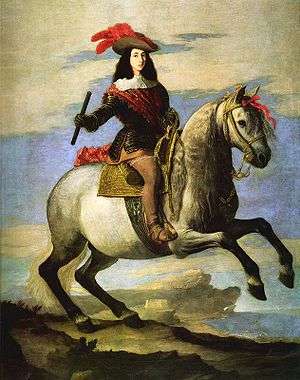Battle of Valenciennes (1656)
| Battle of Valenciennes | |||||||
|---|---|---|---|---|---|---|---|
| Part of the Franco-Spanish War | |||||||
 Don Juan José de Austria, commander of the Spanish army. | |||||||
| |||||||
| Belligerents | |||||||
|
|
| ||||||
| Commanders and leaders | |||||||
|
Vicomte de Turenne Maréchal La Ferté (POW) |
Juan José de Austria Prince of Condé | ||||||
| Strength | |||||||
| 30,000 soldiers[2][3] | 20,000 soldiers[4][5] | ||||||
| Casualties and losses | |||||||
|
7,000 dead or wounded 4,000 prisoners[2][6] | 500 dead or wounded[7] | ||||||
The Battle of Valenciennes (16 July, 1656) was fought between the Spanish troops commanded by Don Juan José de Austria against the French troops under Marshal Henri de la Tour d'Auvergne, Vicomte de Turenne, in the outskirts of the town in the Spanish Netherlands, during the Franco-Spanish War. It was the worst of only a few defeats that the French Marshal Vicomte de Turenne suffered in his long career campaigning and is regarded as Spain's last great victory of the 17th century.[8]
Prelude
On 18 May 1656 the French troops, commanded by Henri de la Tour d'Auvergne, Vicomte de Turenne began to close in and surround the fortified town of Valenciennes which was defended by a Spanish garrison under the command of Francisco de Meneses.[4] The well organised siege began to exhaust the defenders. Towards the end of June, Don Juan José de Austria, the governor of the Spanish Netherlands, took the decision to come to the aid of Valenciennes as its situation was becoming unsustainable.[7]
The French army, consisting of 115 cavalry divisions and 31 of infantry, was divided into a further 2 divisions on each side of the river Scheldt, one of which was under the command of Turenne and the other, under Henri de La Ferté-Senneterre, with the communication problems that this caused.[7]
The Battle
On the night of 15 July just as the fortress was about to surrender, the Spanish army arrived consisting of 81 squadrons of cavalry and 27 of infantry. Don Juan's army dug in about a league from the enemy, preparing to launch an offensive. Four attacks were organised:[7]
- The Spanish and Irish infantry commanded by Don Juan José de Austria and the Marquis of Caracena.
- The nations under the command of the Prince of Ligne, the General leading the cavalry.
- Condé's troops including himself and the Duke of Württemberg.
- The new army which would be led by the Count of Marsin.
Condé came down on Marshal's section with such vigour it surprised and destroyed the French resistance.[7] Don Juan José de Austria stood out due to his brave action, unleashing his might on the French quarters.[7] Turenne then repelled a false attack from the Spanish on his quarters, and went to the aid of Maréchal La Ferté but it was in vain, so he felt obliged to retreat as far as Quesnoy, where he reorganised his forces.[7]
The Spanish captured 400 French officers including Maréchal La Ferté, lieutenant of Turenne and a further 4,000 soldiers (while French sources reduce these figures to 77 officers and 1,200 soldiers)[9] including their belongings and provisions, including an assault train consisting of 50 cannons and all the correspondence of the French command with their court, which allowed the extent of their forces to be known.[7] As for La Ferté's division only 2,000 managed to escape after tossing their arms and making a run for it in total disarray.[10]
Aftermath
The victory at Valenciennes lifted the French siege and contributed greatly to lifting the morale of the Spanish tercios, producing "one of those thunderous achievements that Spain came up with in better days."
However, Turenne had the presence of mind not to allow the French forces to be intimidated by the defeat. His rapid regrouping and redeployment of his forces prevented the Spanish from gaining a decisive advantage on the front.
Philip IV of Spain ordered a gold medal to be printed to commemorate the victory and he had it sent to Condé together with a saber, also made of gold.
For the Spanish, the great victory at Valenciennes proved counterproductive. Emboldened by the success, the Habsburg court at Madrid refused to compromise with French demands but Spanish forces were stretched to their limit despite the great victory.[9] The war dragged on until 1659, when the Spanish government finally signed the Treaty of the Pyrenees, which, with the loss of Dunkirk and nearby areas, was less favourable than would have been possible after the battle of Valenciennes.
See also
Notes
References
- Martín Sanz, Francisco (2003) La política Internacional de Felipe IV. Segovia. ISBN 978-987-561-039-2
- Stanhope (5th earl.) Philip Henry (2005) The life of Louis, Prince of Condé, surnamed the Great. London.
- Hume, Martin Andrew Sharp (2009) Spain Its Greatness and Decay. BiblioBazaar. LLC. ISBN 978-1-113-47089-8
- Stradling, R.A. (1994) Spain's struggle for Europe 1598-1668. London: Continuum International Publishing Group. ISBN 978-1-85285-089-0
- Clodfelter, Micheal (2002) Warfare and armed Conflicts: A statistical reference to casualty and other figures 1500-2000. McFarland. ISBN 978-0-7864-1204-4
- Rodríguez, Ignacio Ruiz (2007) Don Juan José de Austria en la Monarquía Hispánica: Entre la política, el poder y la intriga. Madrid. Dykinson. ISBN 978-84-9849-029-9
- Israel, Jonathan Irvine (1997) Conflicts of Empires: Spain, the Low Countries and the struggle for World Supremacy 1585-1713. London. CIPG. ISBN 978-1-85285-161-3
Coordinates: 50°21′29″N 3°31′24″E / 50.3581°N 3.5233°E